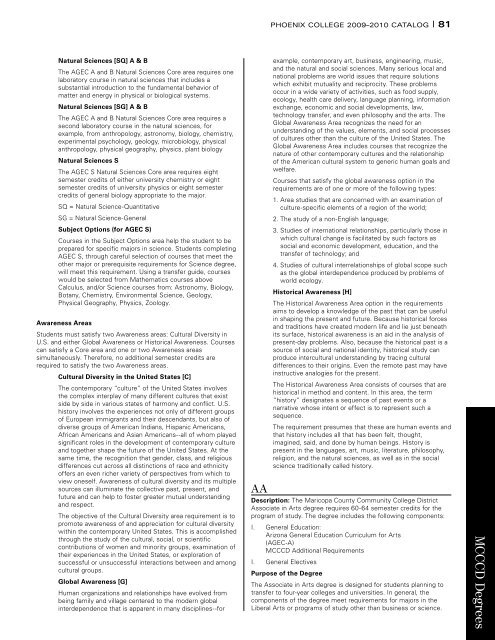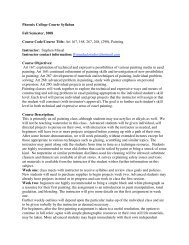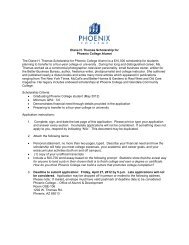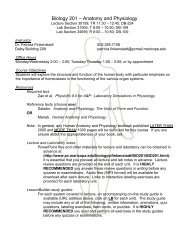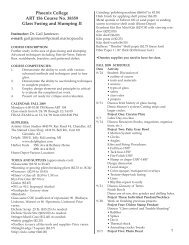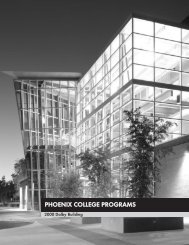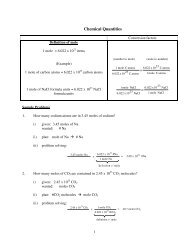Phoenix College Catalog 2009-10
Phoenix College Catalog 2009-10
Phoenix College Catalog 2009-10
You also want an ePaper? Increase the reach of your titles
YUMPU automatically turns print PDFs into web optimized ePapers that Google loves.
<strong>Phoenix</strong> <strong>College</strong> <strong>2009</strong>–20<strong>10</strong> CATALOG | 81<br />
Natural Sciences [SQ] A & B<br />
The AGEC A and B Natural Sciences Core area requires one<br />
laboratory course in natural sciences that includes a<br />
substantial introduction to the fundamental behavior of<br />
matter and energy in physical or biological systems.<br />
Natural Sciences [SG] A & B<br />
The AGEC A and B Natural Sciences Core area requires a<br />
second laboratory course in the natural sciences, for<br />
example, from anthropology, astronomy, biology, chemistry,<br />
experimental psychology, geology, microbiology, physical<br />
anthropology, physical geography, physics, plant biology<br />
Natural Sciences S<br />
The AGEC S Natural Sciences Core area requires eight<br />
semester credits of either university chemistry or eight<br />
semester credits of university physics or eight semester<br />
credits of general biology appropriate to the major.<br />
SQ = Natural Science-Quantitative<br />
SG = Natural Science-General<br />
Subject Options (for AGEC S)<br />
Courses in the Subject Options area help the student to be<br />
prepared for specific majors in science. Students completing<br />
AGEC S, through careful selection of courses that meet the<br />
other major or prerequisite requirements for Science degree,<br />
will meet this requirement. Using a transfer guide, courses<br />
would be selected from Mathematics courses above<br />
Calculus, and/or Science courses from: Astronomy, Biology,<br />
Botany, Chemistry, Environmental Science, Geology,<br />
Physical Geography, Physics, Zoology.<br />
Awareness Areas<br />
Students must satisfy two Awareness areas: Cultural Diversity in<br />
U.S. and either Global Awareness or Historical Awareness. Courses<br />
can satisfy a Core area and one or two Awareness areas<br />
simultaneously. Therefore, no additional semester credits are<br />
required to satisfy the two Awareness areas.<br />
Cultural Diversity in the United States [C]<br />
The contemporary “culture” of the United States involves<br />
the complex interplay of many different cultures that exist<br />
side by side in various states of harmony and conflict. U.S.<br />
history involves the experiences not only of different groups<br />
of European immigrants and their descendants, but also of<br />
diverse groups of American Indians, Hispanic Americans,<br />
African Americans and Asian Americans--all of whom played<br />
significant roles in the development of contemporary culture<br />
and together shape the future of the United States. At the<br />
same time, the recognition that gender, class, and religious<br />
differences cut across all distinctions of race and ethnicity<br />
offers an even richer variety of perspectives from which to<br />
view oneself. Awareness of cultural diversity and its multiple<br />
sources can illuminate the collective past, present, and<br />
future and can help to foster greater mutual understanding<br />
and respect.<br />
The objective of the Cultural Diversity area requirement is to<br />
promote awareness of and appreciation for cultural diversity<br />
within the contemporary United States. This is accomplished<br />
through the study of the cultural, social, or scientific<br />
contributions of women and minority groups, examination of<br />
their experiences in the United States, or exploration of<br />
successful or unsuccessful interactions between and among<br />
cultural groups.<br />
Global Awareness [G]<br />
Human organizations and relationships have evolved from<br />
being family and village centered to the modern global<br />
interdependence that is apparent in many disciplines--for<br />
example, contemporary art, business, engineering, music,<br />
and the natural and social sciences. Many serious local and<br />
national problems are world issues that require solutions<br />
which exhibit mutuality and reciprocity. These problems<br />
occur in a wide variety of activities, such as food supply,<br />
ecology, health care delivery, language planning, information<br />
exchange, economic and social developments, law,<br />
technology transfer, and even philosophy and the arts. The<br />
Global Awareness Area recognizes the need for an<br />
understanding of the values, elements, and social processes<br />
of cultures other than the culture of the United States. The<br />
Global Awareness Area includes courses that recognize the<br />
nature of other contemporary cultures and the relationship<br />
of the American cultural system to generic human goals and<br />
welfare.<br />
Courses that satisfy the global awareness option in the<br />
requirements are of one or more of the following types:<br />
1. Area studies that are concerned with an examination of<br />
culture-specific elements of a region of the world;<br />
2. The study of a non-English language;<br />
3. Studies of international relationships, particularly those in<br />
which cultural change is facilitated by such factors as<br />
social and economic development, education, and the<br />
transfer of technology; and<br />
4. Studies of cultural interrelationships of global scope such<br />
as the global interdependence produced by problems of<br />
world ecology.<br />
Historical Awareness [H]<br />
The Historical Awareness Area option in the requirements<br />
aims to develop a knowledge of the past that can be useful<br />
in shaping the present and future. Because historical forces<br />
and traditions have created modern life and lie just beneath<br />
its surface, historical awareness is an aid in the analysis of<br />
present-day problems. Also, because the historical past is a<br />
source of social and national identity, historical study can<br />
produce intercultural understanding by tracing cultural<br />
differences to their origins. Even the remote past may have<br />
instructive analogies for the present.<br />
The Historical Awareness Area consists of courses that are<br />
historical in method and content. In this area, the term<br />
“history” designates a sequence of past events or a<br />
narrative whose intent or effect is to represent such a<br />
sequence.<br />
The requirement presumes that these are human events and<br />
that history includes all that has been felt, thought,<br />
imagined, said, and done by human beings. History is<br />
present in the languages, art, music, literature, philosophy,<br />
religion, and the natural sciences, as well as in the social<br />
science traditionally called history.<br />
AA<br />
Description: The Maricopa County Community <strong>College</strong> District<br />
Associate in Arts degree requires 60-64 semester credits for the<br />
program of study. The degree includes the following components:<br />
I. General Education:<br />
Arizona General Education Curriculum for Arts<br />
(AGEC-A)<br />
MCCCD Additional Requirements<br />
I. General Electives<br />
Purpose of the Degree<br />
The Associate in Arts degree is designed for students planning to<br />
transfer to four-year colleges and universities. In general, the<br />
components of the degree meet requirements for majors in the<br />
Liberal Arts or programs of study other than business or science.<br />
MCCCD Degrees


